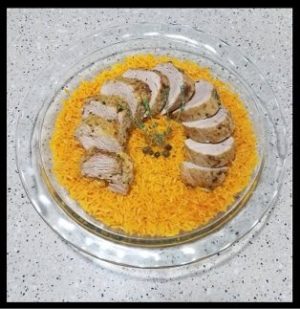
Dijon Pork Tenderloin
What’s inexpensive and surprisingly easy to make? You guess it! Today’s recipe! A little disclaimer: If you’ve never roasted a pork tenderloin before then some of these steps may feel tedious but honestly, once you have it down you will be breezing through this recipe and others in no time!
This recipe is super versatile, and to prove it I’m going to give you TWO ways to make this dish, but your imagination is the limit here. Once you have the preparation down, feel free to experiment [and share] your own version. Here we go!
Aioli [or] Dijon Pork Tenderloin
INGREDIENTS and SUPPLIES:
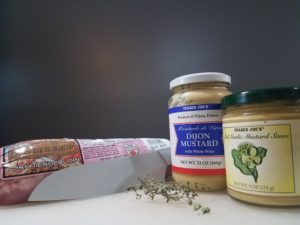
- 1 pork tenderloin (average weight is around 1 – 1.5 lbs)
- 2 tbsp of EVOO
- 1.5 tsp Kosher Salt
- 1/2 tsp fresh cracked black pepper
- 1 tbsp of dijon mustard OR 1 tbsp of aioli mustard
- 3 sprigs of fresh english thyme
- 18 x 13 “half sheet” pan
- Aluminum foil [to cover the sheet]
- Kitchen or Santoku Knife
- Cutting Board
- Small mixing bowl [optional]
- Old plastic grocery [optional]
INSTRUCTIONS:
Preheat oven to 400 degrees F (205 C)
optional: Make your “clean-up” bowl.
1. Pat the tenderloin dry.

2. Trim your pork tenderloin *the most patience is required here*
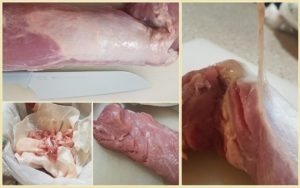 Pork tenderloin is already a very lean cut of pork, but for a truly amazing flavor and even cooking, you want to trim off excess fat and the “silver-skin” [the shiny membrane left over]. To do this I usually scrape my knife lightly across the membrane to loosen up the membrane to find an “opening,” then I slip the tip of my knife under the silvery skin and start slicing back and forth with the sharp edge of the knife angled upward. Remember to keep the membrane tight as you are cutting. Continue to slice the skin off until removed. It’ll take patience but if this shiny membrane layer is not removed it will shrink during cooking which may result in uneven cooking.
Pork tenderloin is already a very lean cut of pork, but for a truly amazing flavor and even cooking, you want to trim off excess fat and the “silver-skin” [the shiny membrane left over]. To do this I usually scrape my knife lightly across the membrane to loosen up the membrane to find an “opening,” then I slip the tip of my knife under the silvery skin and start slicing back and forth with the sharp edge of the knife angled upward. Remember to keep the membrane tight as you are cutting. Continue to slice the skin off until removed. It’ll take patience but if this shiny membrane layer is not removed it will shrink during cooking which may result in uneven cooking.
3. Time to season
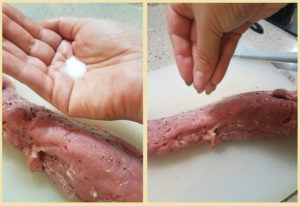 Crack some black pepper on both sides of the tenderloin. Not too much because you don’t want this to be the dominant flavor and fresh cracked pepper is potent! Next is the salt. After watching so many cooking shows I have learned that when they say “under seasoned,” they really mean under salted. I won’t lie to you, if you are salt sensitive like me, then the amount of salt you put on this may seem overwhelming but honestly, you will barely taste it. The TRICK is to salt it just enough to not notice it is missing. Here’s how to gauge: I put enough salt in my hand for that little dip, then I sprinkle salt in a slight and tight zig-zag motion on both sides of the tenderloin. Keep your hand high enough off the tenderloin to evenly disperse salt and not dump a bunch in one spot [Ladies, imagine what happens when you spray dry shampoo too close to your hair… yea, that but with salt! Eek!]
Crack some black pepper on both sides of the tenderloin. Not too much because you don’t want this to be the dominant flavor and fresh cracked pepper is potent! Next is the salt. After watching so many cooking shows I have learned that when they say “under seasoned,” they really mean under salted. I won’t lie to you, if you are salt sensitive like me, then the amount of salt you put on this may seem overwhelming but honestly, you will barely taste it. The TRICK is to salt it just enough to not notice it is missing. Here’s how to gauge: I put enough salt in my hand for that little dip, then I sprinkle salt in a slight and tight zig-zag motion on both sides of the tenderloin. Keep your hand high enough off the tenderloin to evenly disperse salt and not dump a bunch in one spot [Ladies, imagine what happens when you spray dry shampoo too close to your hair… yea, that but with salt! Eek!]
4. Sear for flavor
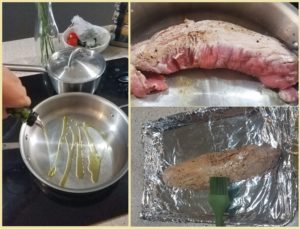 Before you pop this bad boy in the oven, you want to ensure your tenderloin is juicy. To do this you want to sear the tenderloin on medium high heat for a total of 12-15 minutes to get a sear on all sides. Trust me, this will NOT cook the meat all the way through at all, but it will create a nice seal for the juices once in the oven. I’ll even use the tongs to sear the ends for a minute. This is the most important secret step to a GREAT tenderloin.
Before you pop this bad boy in the oven, you want to ensure your tenderloin is juicy. To do this you want to sear the tenderloin on medium high heat for a total of 12-15 minutes to get a sear on all sides. Trust me, this will NOT cook the meat all the way through at all, but it will create a nice seal for the juices once in the oven. I’ll even use the tongs to sear the ends for a minute. This is the most important secret step to a GREAT tenderloin.
5. Baste the tenderloin
 This is where you can get creative! I recommend a simple Dijon mustard if this is your first time, especially since it may already be in your fridge [that’s always fun!]. By the way, kids LOVE doing this part! It’s like painting. Just help them flip the tenderloin so you get a nice coat on all sides. When you’re done, sprinkle the fresh thyme on top and pop it in the oven!
This is where you can get creative! I recommend a simple Dijon mustard if this is your first time, especially since it may already be in your fridge [that’s always fun!]. By the way, kids LOVE doing this part! It’s like painting. Just help them flip the tenderloin so you get a nice coat on all sides. When you’re done, sprinkle the fresh thyme on top and pop it in the oven!
6. You’re Roasting!
 You want to roast until the internal temperature of the pork is 140 F [safe temp]. This should take anywhere from 15 to 18 minutes. DO NOT OVER COOK! Remember that the meat’s internal temperature will continue to increase for a while, even after you take it out of the oven! I took mine out at 140 and it went up to 144! Yikes! Usually I take it out a little sooner. So if you want to take it out around 138 F, you’re more than likely a-ok. Let the meat rest uncovered for 10 minutes. Sometimes I flip it to rest [this gets the juices redistributed nicely].
You want to roast until the internal temperature of the pork is 140 F [safe temp]. This should take anywhere from 15 to 18 minutes. DO NOT OVER COOK! Remember that the meat’s internal temperature will continue to increase for a while, even after you take it out of the oven! I took mine out at 140 and it went up to 144! Yikes! Usually I take it out a little sooner. So if you want to take it out around 138 F, you’re more than likely a-ok. Let the meat rest uncovered for 10 minutes. Sometimes I flip it to rest [this gets the juices redistributed nicely].
Finishing Touches:

Once the pork has rested, flip it back over and slice. Now you can serve it on a long platter or place it nicely over a bed of rice. Yum!

ENJOY!
Monday Musing - Collaborative Blog
You May Also Like

The Pope and Babies
February 1, 2022
Carrot Cake Bread
August 8, 2020

2 Comments
Anonymous
That looks delicious! I never knew cooking pork loin was so easy!
Veronica Franco
It really is! Let me know if / when you try this and how it goes.